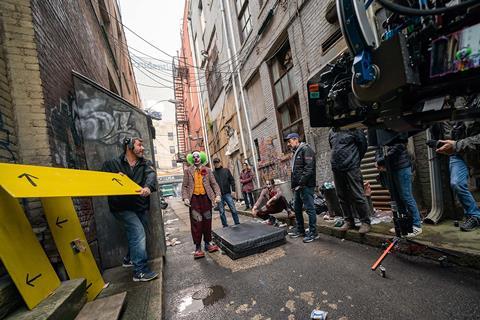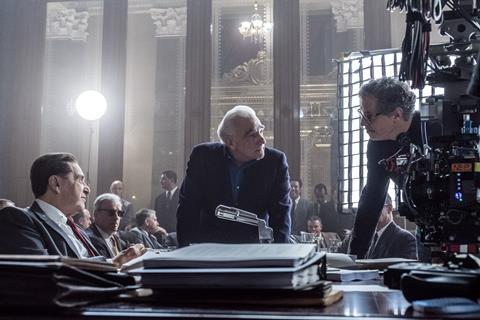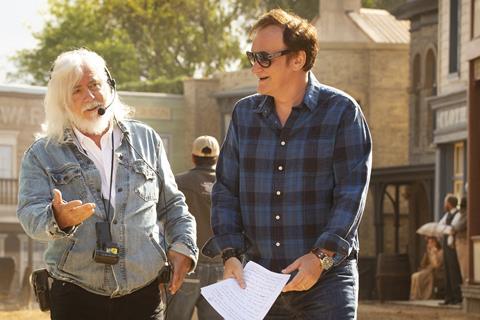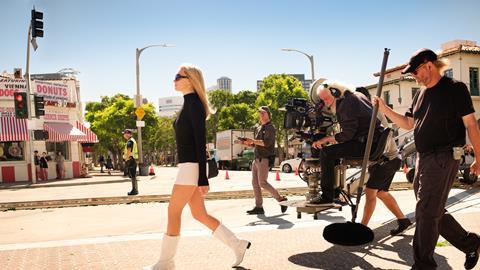The DoPs behind 1917, Joker, The Irishman, Once Upon A Time… In Hollywood and The Lighhouse reflect on the bold choices they made to bring dynamic visions to the screen.
Cinematographers are moving both forward and backward in technological terms this year, ironically in pursuit of the same goal: authenticity.
Avoiding VFX and instead opting to shoot reality has been a central theme. Robert Richardson used real Los Angeles backgrounds for the driving scenes in Quentin Tarantino’s Once Upon A Time… In Hollywood. Roger Deakins contended with real explosions and fires in Sam Mendes’s 1917.
Rigging equipment has also been a common talking point for DoPs in 2019. Deakins pushed the boundaries of stabilising devices to enable extended tracking shots for the continuous-take approach of 1917, while Papamichael explored the limits of large-format cameras, putting them in positions that would have been impossible a few years ago (on a low mounted arm attached to a racing car, in one case). Perhaps most complicated of all was Rodrigo Prieto’s “three-headed monster”, a three-camera set-up used to aid the CGI de-ageing process for Martin Scorsese’s The Irishman.
These and other top cinematographers no longer debate analogue versus digital, with plenty saying it is digital and film, rather than digital or film. This is in part due to rapid advances in camera technology by companies like Arri, with films including 1917 utilising a large-format digital camera that, according to Deakins, is as good as any film camera.
Mixing light sources has also been in vogue, with Lawrence Sher using harsh fluorescents and urban streetlamps to create the heightened eeriness of Joker and grittiness of the city.
Whether they are using old-school filmmaking techniques or the latest technology, these cinematographers are creating brave new worlds for audiences and their craft.
Lawrence Sher - Joker

Lawrence Sher has been known primarily for his work on comedies including Todd Phillips’ The Hangover trilogy, Paul, The Dictator and I Love You, Man, before he reunited with Phillips to create the dark, sinister world of Joker.
While Joaquin Phoenix’s performance threw up regular surprises during the shoot, Sher was a ready and willing partner for the award-winning actor, and says his own work plumbing the depths of the DC Comics arch villain — which won him Camerimage’s Golden Frog award in November — is not as big a departure as it initially appears.
What was the shooting schedule like for Joker?
I read the script about a year before, did an early scout in March [2018] and then prepped for 10 weeks. The shoot lasted 60 days with one day of shooting lost due to issues with the LED lighting on the New York City subway sequence.
What was your approach to Joker’s colour scheme?
My main colour palette was drawn first and foremost from real lighting fixtures that exist in the city. I also looked at movies of that era in which the movie takes place [1981], the colour of the film stock at the time and how it would capture all of this mixed light. The colour palette is a mix of utilitarian light and uncorrected fluorescents — we kept their crappy look so it wouldn’t be clean.
We changed out some of the streetlights so they would be sodium vapour, as opposed to LED which many streetlights are now. When we shot at dusk, you have that blueish light that mixes with the sodium vapours and suddenly you have the colours that I think people associate with the movie: the blues, greens, oranges and greys. You can see the messiness of the city.
How did you approach working with the actors to capture their performances?
On set we maintain a certain rhythm for the actors. If they have to go back to trailer, even for 20 minutes, there is a momentum loss. So if I can shoot fast, they never have to leave the set. It helps everybody, especially the scene.
Todd Phillips encouraged improvisation, for instance the bathroom scene where Joker starts to dance after killing the men in the subway. Did that approach affect the shooting?
That shot was improvisational. He was going to come into the bathroom, hide the gun, wash off the make-up and stand in the mirror and laugh. But with Todd, the movie is constantly being rewritten so you are discovering it as you make it. All of the planning is there but he’s always flexible. With that scene, he wanted to try it non-verbally. He played a piece of music — he didn’t tell the camera operator what was going to happen — and we got that scene in one take.
Was your approach to Joker different to your other films?
My lighting approach is not any different. We are not servicing comedy [in Joker]. Some of the compositions come to the forefront perhaps, more than in my previous works. But my approach, particularly with Todd, is to allow for flexibility and freedom. A lot of it is co-ordination with production design and needing the freedom to be able to light a big space. To have the world lit as opposed to focused on a specific person on a mark.
Which sequence was the most challenging to shoot?
The subway scene where he kills three Wall Street guys. We shot on a stage and with LED panels. It was challenging because while we had more money than other independent films, it’s still a budget issue. Todd had always described it as a fever dream — this kind of escalating light show. We accomplished it with a very expensive row of LED lights on both sides, though not too many LEDs because we tried to keep to the light as they had it in the 1970s and ’80s. I was taking the New York subway all the time and shooting with my iPhone to figure out the lighting for that scene.
How did you find working with Joaquin Phoenix?
It was a transformative experience watching him act and getting to know him. I didn’t say anything to him during prep; he was a little bit intimidating. He apologised to me for acting weird and I said, “No man, do your thing.” We grew to have a good relationship, where we would challenge each other with the choices on set.
Rodrigo Prieto - The Irishman

Mexican cinematographer Rodrigo Prieto has worked alongside acclaimed directors including Alejandro Gonzalez Inarritu (21 Grams, Babel), Ang Lee (Brokeback Mountain) and Pedro Almodovar (Broken Embraces). The Irishman marks his third feature with Martin Scorsese, after The Wolf Of Wall Street and Silence.
Prieto describes the epic crime drama as one of his most challenging projects to date: an intensive 108-day shoot involving more than 300 set-ups, with the added challenge of managing a complicated CGI de-ageing process for the main actors, which incorporated a “three-headed monster” camera rig.
Although Martin Scorsese is an avid supporter of shooting on film, you had to use digital as well to achieve the de-ageing technique.
Yes, 56% was shot on digital and 44% on film. The overall look I thought had to be based on film negative because of the memory aspect. Scorsese talked about home movies, this sensation of remembering the past through images, so I developed looks based on still photography, Kodachrome and Ektachrome.
For the visual effects, it was necessary to shoot with digital cameras where the face had to be replaced with CGI. Visual-effects supervisor Pablo Helman from Industrial Light & Magic needed three cameras synched for every angle and the shutters had to all be in perfect sync. The challenge of getting three cameras to move in unison meant that using film cameras from a practical standpoint was nearly impossible.
Was it Pablo Helman who came up with the idea of using CGI to de-age the actors?
Yes, when we were shooting Silence, Pablo said he thought there was a way to make actors look younger through computer-generated imagery. He came up with a three-headed rig where the central camera, the Red Helium, is capturing the shot and two witness cameras, Arri Alexa Minis, are sat on either side of the main camera to read the infrared map of the actors’ faces. We called it the “three-headed monster”.
Can you talk about the stages of the de-ageing process and how that was achieved?
There are several different stages. Prosthetics were used to make the actors look older. Make-up could make the actors look younger, for example making a 70-year-old actor look like they were in their 50s. VFX and CGI de-ageing were used when the actors are close to the transition to make-up, and that was complicated as the ageing transition was subtle, say, only a few months in time rather than several years. The technical and make-up teams had to be sure the transition was smooth.
How did you map out the visual arc of a film that spans five decades over three-and-a-half hours?
We did not want to make it over-stylised or flashy. Scorsese wanted the camera to reflect the way Frank Sheeran [played by Robert De Niro] approached his job, which was simple, methodical and repetitive. The audience sees the same shots with Frank — the camera pans around at the same angle. When we were with other characters, like crazy Joe Gallo, the camera behaves differently.
How did the fact the film was made to screen first and foremost on Netflix affect the way it was shot?
For the most part it wasn’t a consideration. Scorsese designs his shots in a way that helps the story. The one thing we did change was the aspect ratio. Normally, Scorsese would use widescreen but in this case we thought we had better use 1.85 because it would fill up home screens. It also fit Frank’s personality more, as well as helping to show the height difference between the characters. Frank was a tall man so we made special shoes for De Niro and boxes with cushions where he sat. For accuracy, we also changed his eye colour to blue.
You were working on a tight schedule. Was there any room for improvisation during the shoot?
When the actors want to try something different, Scorsese will almost always go for it. Near the end of the film, Frank is looking as his car is being washed and it’s a defining moment. We lit the scene for him standing and always looking at the car. Then De Niro said, “I always kind of imagined being inside the car.” So Marty said, “Oh, OK, let’s do that.” I had to set it up in three seconds. As soon as we shot it, I could see that his performance was there.
Jarin Blaschke - The Lighthouse

Born in the Los Angeles suburbs, Jarin Blaschke continues a collaboration with filmmaker Robert Eggers that began on the latter’s 2008 short The Tell-Tale Heart and encompassed his haunting 2015 feature debut The Witch. For The Lighthouse, the pair conjured up another strange and foreboding world: a mysterious New England island in the 1890s, inhabited by lighthouse keepers Robert Pattinson and Willem Dafoe. Blaschke deployed innovative lighting and lensing solutions to take on not just the wilds of authentic Nova Scotia locations, but the demands of dark, cramped, wet settings.
How many years did it take to develop the concept of The Lighthouse?
I didn’t have a script until a month or two before prep, but Rob first pitched this idea probably three years before that. With him, it starts with atmosphere, so my subconscious was working on the atmosphere at the same time that we were developing The Witch. We didn’t know which one would go [first] and then The Witch happened.
The Lighthouse was shot in black and white, with a 1.19:1 aspect ratio, on Kodak Double X 35mm film format, which dates from the 1950s. How much testing did you do?
There was a battery of tests I put myself through, like testing real oil lamps to see how to do it with an electrical lamp. I had to know how to light differently: I bolstered the light levels by 15, sometimes 20 times, and the film stock had to be tested in rain, backlit to know where it looks like night but also doesn’t look overly lit.
What logistical challenges did you face shooting on location in Nova Scotia?
The weather was bad and added about four days to our schedule. It could have been worse but we had a covered set. We couldn’t do a night scene one night because it was too windy and even with day scenes, you have frames where you need to bounce light back using a giant sail and it gets a little hairy. There was a lot of eating cold porridge in the dark in the morning and the breakfast tent was going to blow away. We had to build this hardcore tent just to have breakfast. It adds to the movie, I hope.
In exploring the space between reality and insanity in The Lighthouse, did you use special lenses for certain scenes?
I went to Panavision. I know vintage lenses are really trendy right now. I had some experience with the usual suspects: Cooke Series 2s and Super Baltars [used in The Godfather and The Birds]. They put original Baltars in front of me and I fell in love with them. So we had old Baltars from the 1930s. We used the first high-speed portrait lens of the 19th century for special shots, like [Robert Pattinson] having sex with a mermaid, the hand going down the body. Stuff that was super heightened where we could get away with it.
How did your collaboration with Eggers inspire you for certain images?
I’ve known Rob for 12 years so I knew there were going to be a lot of symmetrical two-shots. There is one direct reference to a Sascha Schneider painting. And the last scene in the film is in the lookbook. Those are the only two references, everything else I tried to create. I know Rob watched all kinds of crazy stuff, like videos with shark genitals.
You are also working on Eggers’ next film, The Northman. What can you say about it?
Rob says very little. It’s a bigger movie than the others. I can say it’s a Viking revenge movie and we are shooting in Europe. I think he feels a responsibility to do a trilogy. It’s dark and unusually violent.
Robert Richardson - Once Upon A Time… In Hollywood

A nine-time Oscar nominee and three-time winner, Robert Richardson’s career has been closely associated with three filmmakers: Oliver Stone, Martin Scorsese and Quentin Tarantino. For Stone, he photographed 11 features in a little over a decade, winning the Oscar for JFK; two of his five collaborations with Scorsese brought him Oscar statuettes (The Aviator and Hugo); and he shared Camerimage’s director and cinematographer duo award with Tarantino for their work across six films including Once Upon A Time… In Hollywood. Richardson is known across the industry for pushing boundaries and doing whatever it takes to achieve a shot.
How would you typify your relationship with Quentin Tarantino?
A relationship with a director is a marriage. I have been fortunate enough to forge a series of relationships with all of the directors I’ve worked with from the beginning. It’s the idea that you are linked together and begin to understand how the other speaks, what you like and don’t like. It’s so important. Collaboration at that level is why rock ‘n’ roll bands are the very best when they hold out and play together as the same team as long as they can. The Beatles wouldn’t have been who they were without John, Paul, George and Ringo.
What is your creative process like with Tarantino once you’ve read the script?
Quentin was in the room when I first read the [Once Upon A Time… In Hollywood] script. It took me a substantial time to read it. After we had dinner, we made notes and then he played music: ‘Good Thing’ from Paul Revere & The Raiders, ‘Mrs Robinson’ from Simon & Garfunkel, ‘California Dreamin’ from Jose Feliciano. The soundtrack is like a character in the film; it leads you, it is continuously playing from a radio station. The music helped build on the emotion of the characters and the movement of the film.
What is Tarantino’s process for selecting shots?
He only shoots on film, he only processes on film and he only watches dailies on film. He doesn’t see digital replication until he gets to the Avid in the editing room. Our process is to shoot a film chemically, process and print chemically, and that print is duplicated on a 35mm projector. You then project the film as well as the digital intermediate, and they need to replicate each other perfectly, otherwise Quentin doesn’t want to discuss it. It’s definitely challenging, but that’s how we get to be better artists.
And when filming, Tarantino always sits beside the camera?
Quentin is a director not a selector. He sits beside the camera. There is no video village, there is no video replay. You don’t go back and look at something. He watches the actors and their performance. If he’s got it, it’s over. If there is an error, something happened or an actor needs a retake, he will listen to why, but he will always choose in the editorial process the very best performance. The film is golden in its use of warm, saturated colours. We wanted to make a film that was about California and sunshine. On my side, it’s a combination of film stock, lenses and light. For the golden exteriors, we used a combination of Panavision’s anamorphic lenses and golden lenses.
You are known for using myriad film stocks to achieve different looks. What did you use for this film?
We shot 35mm anamorphic, except when shooting Rick Dalton’s western television series, then we were 35mm black and white, and we shot with spherical zooms mostly in 1.33. There were also two sequences at Sharon Tate and Roman Polanski’s home that we shot on Kodak Ektachrome, one in 16mm black and white and the other on Super8mm colour.
Roger Deakins - 1917

Winner of four Baftas and an Oscar (secured last year for Blade Runner 2049 on his 14th nomination), the prolific Deakins has been an influential figure in cinematography since he burst on to the scene with 1984. On that film he pioneered a bleach bypass process to achieve a washed-out look that went on to be used in films including Se7en and Saving Private Ryan. He has also been at the forefront of embracing digital filming methods, not least on Sam Mendes’s Skyfall.
He reunites with Mendes on 1917, which follows two soldiers on a mission to avert a strategic disaster during the First World War. Deakins and Mendes had to invent new ways to move the camera to create the impression that the narrative was unfolding in a single, continuous shot — an innovative feat that puts the audience on the frontline.
How did you achieve so much fluidity in single camera shooting?
We used a lot of different rigs. Probably 60% of the film was shot on a stabilised remote head. Some shots are done on the Trinity [Arri stabiliser rig], some are done on the conventional Steadicam and there’s even a drone. But the majority of the film is done remotely with a stabilised head that’s either carried by the grips or a tracking vehicle on the end of a crane or on a wire.
How did you plan such incredible camera movement while keeping up the illusion of one continuous shot?
Sometimes it’s put on to a wire and then moved, or it’s taken off the wire and then someone carries it or runs with it so it all becomes one shot. The reason was not only to sustain the scene but also that we didn’t want to cut in some of the obvious places.
Were you pushing the existing technology, or did you have to create new methods?
We created some of our own. For instance, running with speed down a trench in front of two characters like we were, you can’t do that on Steadicam. So a Steadicam operator came up with the design of little mini-posts with gyros on them, and we put a very small remote head on top. He would run down the trench facing forward with the camera facing backwards over his shoulder, which I was remotely operating. Then he’d get to a corner in the trench and segue around so he started on a front shot.
How did you communicate with the operating team on the ground?
I’d be operating remotely. I don’t like wearing earphones because I’m constantly running to and from the set talking to grips or whoever. James [Deakins’ wife and digital workflow consultant] would be on set wearing earphones and relaying messages to the crew. During a shot, she would say things to the operating team like “faster, faster” or “you are getting too close, a little to the left”. It helped because they couldn’t see what the camera was seeing.
How integral were the four months of rehearsals?
The trick was for Sam and me to figure out what we wanted to do: where we wanted the camera and to finesse the camera moves relative to the actors. We tested specific rigs on specific kinds of shots. That was the big trick, really, practising with different pieces of equipment. We also went to Salisbury Plain and mapped out all the shots we wanted before anything was dug or built, such as the farmhouse.
How was the weather integral to the film?
Being such an exterior movie, we were very dependent on the light and the weather. And we realised you can’t really light it. If you were running down a trench and turning around 360 degrees, there’s nowhere to put a light. Because we were shooting in story order, we had to shoot in cloud to get the continuity from scene to scene. Some mornings the sun would be out and we couldn’t shoot so we would rehearse instead.
The shooting in 1917 had to be in sync with the editing. How did that process work?
Sam had to choose the take he wanted before we did the next shot because we had to match them, like the beginning of the B side had to match the end of the A side. That frame and the camera movement and the position of the actors had to match exactly. We would have the take on playback, and set up the incoming take and keep playing the beginning to match the end of the shot. That’s the great thing about video assist and being able to overlay the two images.
You were one of the early adopters of digital shooting. What won you over?
The Arri Alexa tipped the point for me between film and digital. I find it a bit of a non-argument. I think it’s what’s in the frame and where you point the camera.

























No comments yet